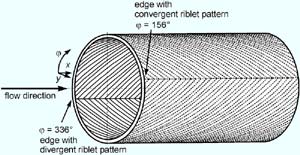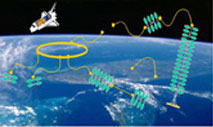Process Engineering
This special field revolves around processes for modifying material properties (milling, cooling), composition (filtration, distillation) and type (oxidation, hydration).
Valuable information is available on a broad range of technologies including material separation, laser processes, measuring techniques and robot engineering in addition to testing methods and coating and materials analysis processes.

Fluid flow technology takes a cue from fast-swimming sharks
A study of airflow in pipes may help solve a mystery concerning the ears of fast-swimming sharks. The results could also lead to new audio technologies, according to an engineer at Ohio State University.
Konrad Koeltzsch, a postdoctoral researcher in chemical engineering and the Alexander von Humboldt Fellow at Ohio State, and his colleagues investigated grooves in sharkskin called riblets.
Koeltzsch began to study sharkskin while he was a postdoctoral researcher at the Dresden Uni

Ultrasound shown to be potentially safe, effective way to kill bacteria
High-power ultrasound, currently used for cell disruption, particle size reduction, welding and vaporization, has been shown to be 99.99 percent effective in killing bacterial spores after only 30 seconds of non contact exposure in experiments conducted by researchers at Penn State and Ultran Labs, Boalsburg, Pa.
In the experiments, bacterial spores contained in a paper envelope, were placed slightly (3mm) above the active area of a specially equipped source of inaudible, high frequency (70

Improved Fabrication of High Resolution Printed Circuit Boards (PCBs)
Through precise control of the etching process, an inventor in Oxford University’s Photofabrication Unit has made the reliable production of High Resolution Printed Circuit Boards (PCBs) with conductors down to 10 µm wide more of a cost-effective reality.
With increasing demands for greater miniaturisation and the use of flexible circuitry, the need for improved fabrication methods for high resolution printed circuit boards is becoming more important. PCBs currently include conductors with

Gas leak detector
Micro-sensors, developed by the CEIT Technology Centre with the help of Gas de Euskadi, operate by detecting gas leaks and reducing the risks of poisoning through the inhalation of carbon monoxide gas.
Through research involving help from Gas de Euskadi, CEIT has developed a system based on micro-sensors that can detect domestic gas leaks. The increasing use of natural gas in homes, the future regulations for carbon monoxide detection in domestic situations and the growing demand for

Robot Space Cowboys
A unique University of Southern California design for self-organizing robots controlled by “hormonal” software is moving toward space.
At the Robosphere 2002 conference held at the NASA Ames Research Center in Silicon Valley November 14-15, Wei-Min Shen of the USC School of Engineering’s Information Sciences Institute (ISI) presented an overview of an audacious project to have pieces of the proposed half-mile-long Space Solar Power System satellite put themselves together–self-a

Sound waves to chill ice cream in new freezer case concept
Penn State acousticians have achieved proof of concept for a compact ice cream freezer case based on “green” technology that substitutes sound waves for environment-damaging chemical refrigerants.
Dr. Steven Garrett, the United Technologies Corporation professor of acoustics at Penn State, leads the research team conducting the project with financial support from Ben & Jerry’s and its parent company, Unilever.
“In our proof-of-concept test system, there is no ’test freeze